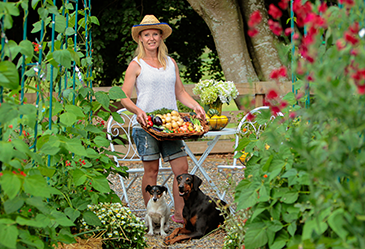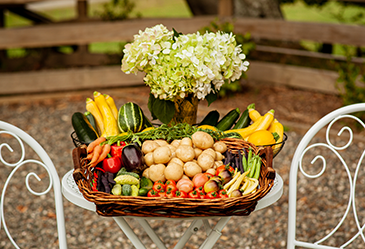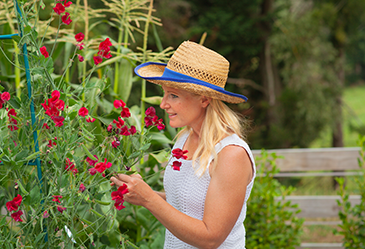Hello! I’m Leah, and I come from a family of gardeners. We live in rural south Rotorua, where we aim to be as self-sufficient as possible. We run beef, sheep, and hens for eggs. Our two miniature horses and two dogs complete the picture, along with many native birds. You can follow me on my garden journey here.

Our property is well established, and already had walnut, chestnut, and fruit trees. It took around 18 months of hard graft to create the growing spaces we have now. Old window frames, piping, and cobblestones left in a shed were re-purposed into garden structures. Hundreds of barrows of soil, manure, and compost lie in eight large raised beds, as well as several pots and containers, and a Vegepod. We also have large flower gardens, which the bees love, a symbiotic and beneficial relationship to our food-growing ecosystem. A farm stand at the gate offers eggs, flowers, and seasonal produce; much is gifted to family and friends as well which is a lovely bonus of growing your own food. This year I wanted to grow more pumpkins without compromising space for other crops, so last winter I dug a long trench at the top of an un-used bank adjacent to our new mini orchard, and filled it with layers of compost, manures, and rotten silage. The idea was to encourage the pumpkins to cascade down into the orchard to benefit from bees attracted to wildflowers planted underneath the fruit trees.
In between the pumpkins I have corn as well, to make the most of the space. This will be my favourite early autumn harvest, along with kumara. For autumn I have just sown seeds for beetroot, broccoli, carrots, and parsnips. Looking forward to adding these crops back into my patch! We have unique environmental challenges; winters are cold and wet, summers hot and dry. We had a -7 degree frost and three consecutive days of hard frost last winter. Our soil composition generally means rain does not ‘pool’ in winter, but makes long hot summers tricky; volcanic pumice does not hold water. I am learning what is doable by studying the weather, planning ahead, and learning from past failures. Gardening is like science: theory, experiments, and analysis. However, intuition, patience, hard graft, nurturing, and resilience are all valuable allies when working with the natural environment too.


Gardening is a fabulous holistic platform for wellbeing. Gardening allows me to be active, connect with like-minded people and the natural environment, along with building knowledge, not to mention the health benefits my family and I gain from nutrient-rich homegrown food. Not every New Zealander has access to fresh food, so I decided I could contribute to public health by voluntarily teaching kids from an under-privileged primary school how to grow and cook food. What positively grows wellbeing doesn’t have to be complicated to be effective. Give growing a go! Start simple with what you and your whanau eat, trying different varieties to keep your plate colourful. Go vertical where possible to maximise the space by under-planting as well; tubs and pots are great! Ask loads of questions, and remember the best gardeners have failures too. Like I tell my gardening kids: ‘Do the mahi, get the kai!’
Post a comment
My Pride of Place: Mrs Evans Garden Comments
Heartwarming story, enjoyable to read
Donna
Living the dream Mrs Evans. Loved reading your article. Trying to grow vertical with trellis. Would love to see photos of your pumpkins.
Adele McLean